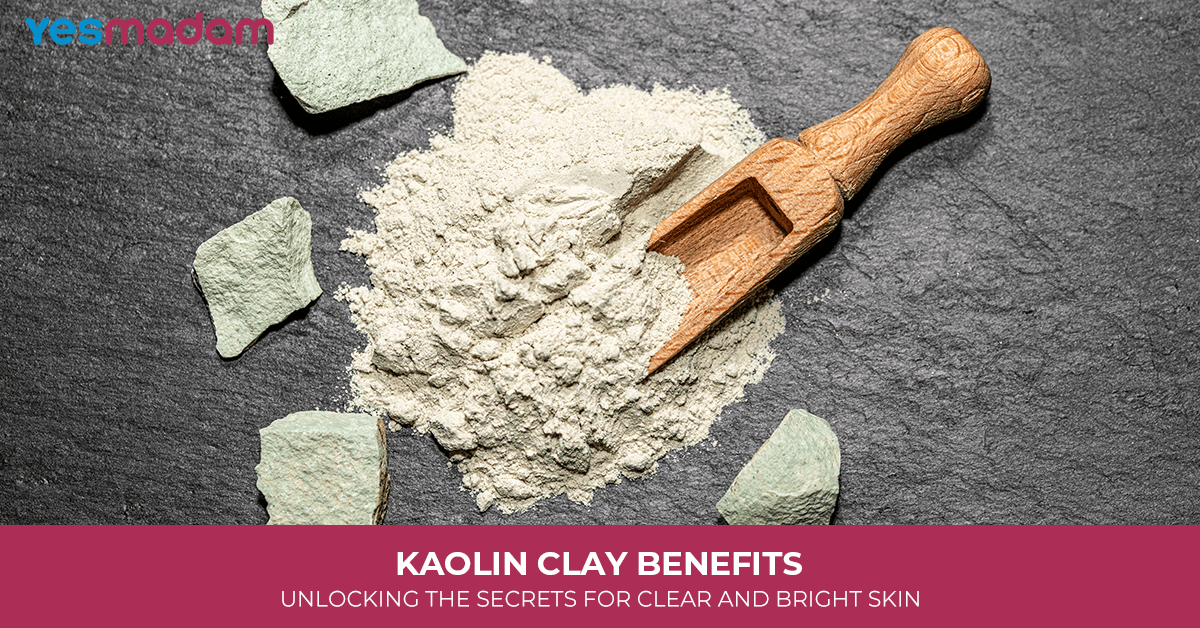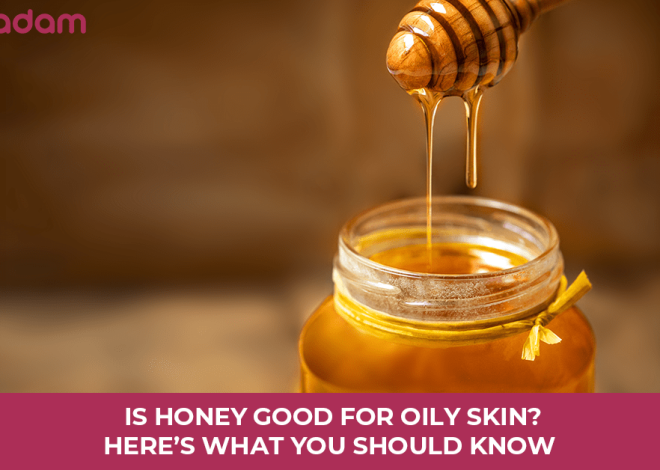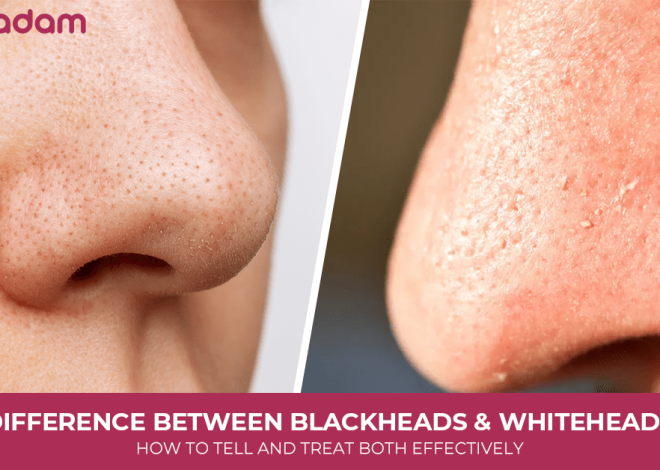
Kaolin Clay Benefits: Unlocking The Secrets for Clear And Bright Skin
If you’ve applied bentonite clay as part of your natural beauty routine, but you’re searching for something a bit milder, then kaolin clay may be the best option.
You may use this all-natural soft ingredient, enriched with necessary minerals, as an exfoliator, cleanser, and even mask.
Scroll down to know the kaolin clay benefits for skin and how it can help improve the texture and complexion of your skin with every use.
Table of Contents
What is Kaolin Clay?
Kaolin clay, also known as white clay, china clay, or chini mitti, is a naturally occurring soft and fine clay made up of the kaolinite mineral. It is a tender facial clay that cleanses, exfoliates, and detoxifies your skin gently from the inside out.
This clay is the outcome of feldspar-rich rocks withering over the years to create a pure, versatile, and highly textured clay. Kaolin is usually found everywhere in Europe, Southern America, and Asia.
How Does Kaolin Clay For Skin Work?

In the realm of skincare and cosmetics, kaolin clay has gained prominence for its remarkable exfoliating properties. Here’s how it works :
- The clay enters the skin and absorbs all the oil, dirt, and other small particles that may have a dampening effect on your natural skin glow.
- It attaches itself well to impurities, and when rinsed off, it helps unclog skin pores and reduce excess oil and sebum from the skin.
- It also works by inhibiting the formation of bacteria, which is known for causing dark spots, pigmentation, and blackheads on the skin.
Thus, the clay works through cleansing, exfoliation, and detoxification to reveal naturally glowing skin and protect your skin from environmental damage.
What are the Different Benefits of Kaolin Clay for Skin?
Here are the 7 kaolin clay benefits for skin that will help your skin look healthy and glowing :
Acne Treatment
Kaolin clay is an excellent option to battle acne and the irritation that accompanies it. The clay absorbs excess oil and impurities that may clog pores and cause breakouts. Regular use helps minimize the appearance of irritation and redness.
Oil Absorption
Absorbs extra oil from your skin’s surface and helps keep your pores unclogged. Only controls the excess sebum production without affecting the skin surface’s natural oil level.
Soothes Irritation
The clay has excellent soothing qualities that may help calm your irritated skin due to an insect bite or any skin rash. The mild healing properties soothe any type of irritation and redness on the skin.
Exfoliator
The clay is also one of the best exfoliators. It may eliminate even the tiniest amount of dirt, bacteria, and pollutants from your skin, thereby keeping the acne problems at bay.
Hydrate your skin
The natural vitamins and minerals in kaolin have hydrating properties that may help keep the skin supple and soft. Infused with silica, it is one ingredient that tends to absorb excess oil without absorbing the necessary moisture to keep your skin moisturized and prevent dryness.
Detoxification
One of the remarkable benefits of this clay is that it absorbs excess dirt, toxins, and impurities from the skin. It is a natural detoxifier, effectively eliminating dirt and promoting a clearer and cleaner complexion.
Skin Brightening
People often wonder does kaolin clay whiten skin? The answer is yes. It works to even out skin tone, minimize the appearance of dark spots, and promote a more luminous complexion.
Pamper Yourself with Yes Madam 💆♀️✨
Get salon, spa & beauty services at home –
professional, hygienic & affordable.
Your beauty, our responsibility 💜💖
4 DIY Kaolin Clay Uses In Skincare

From the benefits, it is clear that there are versatile kaolin clay uses. Here are the 4 DIY examples of how to use the clay for skin.
| DIY Kaolin Clay Method | How to use | Benefits |
| Kaolin clay uses for skin whitening | Mix 2 spoons of kaolin clay,1 spoon of avocado oil, and 3 spoons of rose water. Apply this over cleansed skin. | Helps you get clear, glowing, and bright skin. |
| Kaolin clay for acne | Mix 2 spoons of white kaolin clay powder, 1 spoon of jojoba oil, 2 drops of tea tree oil, and rose water each. Apply to a cleansed face. | Removes acne-causing bacteria from the pores. |
| Kaolin clay for lips | Mix 1 spoon of kaolin clay powder, ½ spoon of shea butter, 1 spoon of jasmine floral water. Apply as a natural scrubber for lips. | Provides soft, supple, pink lips. |
| Kaolin clay spot treatment | Make a thick paste using kaolin clay and water. Apply directly to the affected parts. | Promotes faster healing of blemishes. |
4 Different Types of Kaolin Clay and Their Uses
There are 4 different types of kaolin clay, each with its unique properties and benefits for skin. For example:
| Kaolin clay type | Benefits for skin | Best for |
| White kaolin clay | It is the mildest and most versatile form of clay used in gentle cleansers, exfoliating scrubs, and masks. | All skin types, especially dry and sensitive skin types. |
| Yellow kaolin clay | Improves circulation and provides a radiant glow to the skin. | Combination or oily skin. |
| Red kaolin clay | Removes impurities, minimizes excess oil, and promotes a brighter complexion. | Oily and acne-prone skin. |
| Pink kaolin clay | Absorbs toxins and clogged oil from the skin, while battling skin irritation and dryness. | Normal skin types, dry skin . |
Safety Practices and Tips for Using Kaolin Clay on Skin
To safely use Kaolin clay, always patch test it on a small skin area, cleanse your skin before application, and avoid letting the mask completely dry to prevent over-drying.
Before Use
- Patch Test: Before applying Kaolin clay to your face, perform a patch test on a small, discreet area of skin to check for any allergic reactions or irritation.
- Choose Quality Clay: Purchase cosmetic-grade Kaolin clay from a reputable supplier to ensure purity and safety.
- Use Non-Metal Tools: Mix the clay with water or another liquid in a glass, ceramic, or wooden bowl using the same type of utensil to prevent loss of potency.
During Use
- Start with Clean Skin: Apply the Kaolin clay mask to a clean, dry face for better absorption and results.
- Apply Evenly: Distribute the mask evenly across your face, being careful to avoid the sensitive areas around your eyes and lips.
- Monitor Drying Time: Do not leave the mask on until it’s completely dry and starts to crack; instead, rinse it off when it’s just starting to get tacky.
- Avoid Over-Exfoliation: Limit the use of Kaolin clay products to one to three times a week to prevent excessive dryness or over-exfoliation.
After Use
- Rinse Gently: Use lukewarm water to rinse off the mask, avoiding harsh scrubbing.
- Pat Dry: Gently pat your face dry with a clean, soft towel.
- Moisturize Immediately: Apply a moisturizer suited to your skin type to restore hydration and replenish the skin’s moisture barrier.
Conclusion
Kaolin clay benefits show that this versatile clay can soothe, exfoliate, and purify the skin. Whether you have oily skin, sensitive skin, or simply want to enhance your skin’s overall health, including kaolin clay in your skincare routine can bring about remarkable benefits for achieving healthy, radiant skin.
FAQs
What are koalin clay powder benefits?
Kaolin clay powder is beneficial for skincare by gently exfoliating, absorbing excess oil, and purifying skin, making it suitable for all skin types, including sensitive and oily skin..
Is it safe to use kaolin clay on the skin every day?
No, it’s generally not recommended to use kaolin clay on your skin every day, as it can be too drying, even though it’s a mild ingredient.
Which is better, multani mitti or kaolin clay?
Neither is definitively “better”; the best choice depends on your skin type and concerns. Choose Kaolin clay for sensitive, dry, or mature skin because it is a gentle cleanser, is less absorbent, and helps retain moisture.
Can I mix kaolin clay with Multani Mitti?
Yes, you can mix Kaolin clay with Multani Mitti to create a face mask, as both clays are often combined for their complementary benefits in skincare routines.
Can kaolin clay cause acne?
No, kaolin clay does not typically cause acne; in fact, it is often used to prevent and treat acne by absorbing excess oil, unclogging pores, and providing a gentle cleanse without drying out the skin.
Is kaolin clay anti-inflammatory?
Yes, kaolin clay is considered to have anti-inflammatory properties that help soothe redness and irritation on the skin.
What is kaolin clay called in India?
In India, Kaolin clay is primarily known by its common names, China Clay or White Clay.
What is the pH of kaolin clay?
It has a relatively neutral pH level of around 4.5, which is close to the skin’s natural pH of 5.5.
What is the active ingredient in kaolin clay?
The primary active component in kaolin clay is the mineral kaolinite, which is a hydrated aluminum silicate with the chemical formula Al₂Si₂O₅(OH)₄
How long to leave kaolin clay on the face?
Leave a kaolin clay mask on your face for 10-15 minutes, or until it’s about 80-90% dry, but avoid letting it dry completely and become crackly to prevent excessive skin dryness.



